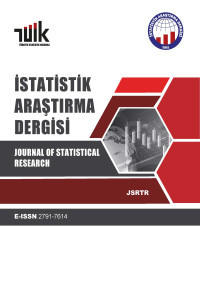Kappa Katsayısının En Çok Olabilirlik Tahmin Edicisinin Simülasyon Çalışmasına Dayalı Elde Edilmesi
Kappa Katsayısı, Lojit Model, Olabilirlik Fonksiyonu
Maximum Likelihood Estimation of the Kappa Coefficient Based on A Simulation Study
Kappa Coefficient, Logit Model, Likelihood Function,
___
- Bahadur, R.R., 1961. A Representation of the Joint Distribution of Responses to n Dichotomous Items, in Solomon, H.(ed). Studies in Item Analysis and Prediction, Stanford University Press, California, 158-176.
- Bishop, Y.M.M., Fienberg, S.E., Holland, P.W., 1988. Discrete Multivariate Analysis: Theory and Practice, The MIT Press, The Massachusetts Institude of Technology, England.
- Cohen, J., 1960. A Coefficient of Agreement for Nominal Scales. Educational and Psychological Measurement, 20 (1), 37-46.
- Kraemer, H.C., Periyakoil, V.S., Noda, A., 2002. Kappa Coefficient in Medical Research. Statistics in Medicine, 21, 2109-2129.
- Lipsitz, S.R., Williamson, J., Klar, N., Ibrahim, J., Parzen, M., 2001. A Simple Method for κ Between A Pair Of Raters. Journal of Royal Statististical Society A, 164 (3), 449-465.
- Shoukri, M.M., Mian, I.U.H., 1996. Maximum Likelihood Estimation of the Kappa Coefficient from Bivariate Logistic Regression. Statistics in Medicine, 15, 1409-1419.
- ISSN: 1303-6319
- Başlangıç: 2002
- Yayıncı: TÜİK
Kappa Katsayısının En Çok Olabilirlik Tahmin Edicisinin Simülasyon Çalışmasına Dayalı Elde Edilmesi
Behrens-Fisher Problemi ve Çözüm Yöntemleri
Kategorik Verilere Faktör Analizinin Uygulanması
Mevlüt TÜRE, İmran KURT, Hülya TÜRE
Türkiye’de Bölgesel Farklılıkların Kırsal Ölçekte Analizi
Mehmet GÜRBÜZ, Murat KARABULUT, Ersin Kaya SANDAL
Yaş Sınıflarının Doğurganlık Değeri Üzerindeki Etki Payları
Mevsimsel Kesirli Bütünleşik Akgürültü Sürecinde Otokorelasyonlu Regresyon Yöntemi
Büyüme Eğrilerinin Eşitliğinde Permütasyon Testi
Abdullah YEŞİLOVA, Barış KAKİ, İsmail KASAP
Satın Alma Gücü Paritesinin Uzun Dönemde Geçerliliğinin Panel Birim Kök Testleri ile Sınanması
Çoklu Regresyon Uçdeğerlerinin Teşhisçisi Olarak Çanta Çiziti
